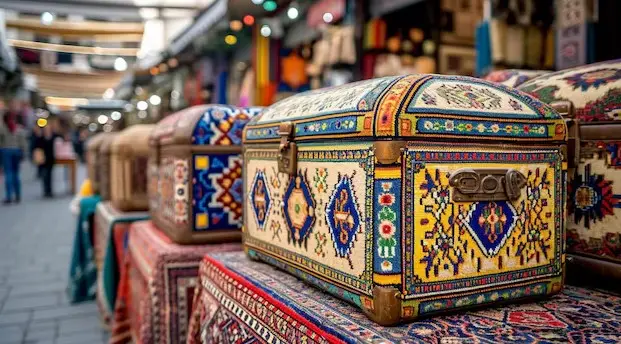Introduction: Embarking on a Global Crafting Adventure
Embark on a journey through the intricate world of handmade crafts, where tradition and innovation intertwine to create mesmerizing works of art. In this immersive exploration, we’ll traverse continents and delve into the rich tapestry of crafting techniques practiced by artisans worldwide. From the sun-drenched shores of Africa to the quaint cobblestone streets of Europe and the bustling markets of Asia, join us as we uncover the secrets behind some of the world’s most cherished handmade treasures.
African Crafting Techniques: Weaving, Beadwork, and Mud Cloth
Weaving
Weaving is a time-honored tradition across Africa, with artisans skillfully crafting textiles using traditional hand looms. From the intricate patterns of Ghana’s kente cloth to the vibrant hues of South Africa’s Ndebele art, each fabric tells a story of cultural identity and heritage. The rhythmic clack of the loom echoes the rich tapestry of African life, connecting past and present in a celebration of craftsmanship.
Beadwork
Beadwork holds a special place in African culture, with artisans using colorful beads to adorn jewelry, clothing, and ceremonial objects. Each bead carries its own significance, often symbolizing aspects of spirituality, identity, or social status. From the intricate beadwork of Maasai jewelry to the bold designs of Zulu necklaces, African beadwork is a testament to the creativity and ingenuity of its makers.
Mud Cloth
Mud cloth, or bogolanfini, is a traditional Malian textile crafted using fermented mud as a dye. This ancient technique results in striking geometric patterns that are both visually captivating and steeped in cultural significance. Each mud cloth design is imbued with meaning, representing aspects of Malian identity, history, and social status. From elaborate ceremonial robes to everyday garments, mud cloth continues to be cherished as a symbol of Mali’s rich cultural heritage.
European Crafting Techniques: Pottery, Lacework, and Glassblowing
Pottery
Pottery is a cornerstone of European craftsmanship, with each region boasting its own distinct styles and techniques. From the rustic majolica pottery of Italy’s Amalfi Coast to the delicate porcelain of England’s Staffordshire region, European pottery reflects the diverse cultural heritage of the continent. Skilled artisans mold clay into exquisite vessels, plates, and sculptures, each piece bearing the mark of its maker’s hands and the history of its origins.
Lacework
Lacework is synonymous with European elegance and refinement, with centuries-old traditions still thriving in regions like Belgium, France, and Italy. Artisans painstakingly weave delicate threads into intricate patterns, creating ethereal fabrics that are used in fashion, home decor, and ceremonial attire. From the intricate motifs of Belgian bobbin lace to the delicate Chantilly lace of France, European lacework is a testament to the skill and artistry of its makers.
Glassblowing
The art of glassblowing has flourished in Europe for centuries, with Italy’s Murano Island being a renowned center of excellence. Skilled artisans use ancient techniques to transform molten glass into stunning works of art, from delicate vases to elaborate chandeliers. Each piece is a masterpiece of craftsmanship, with intricate designs and vibrant colors that capture the imagination and inspire awe.
Asian Crafting Techniques: Origami, Batik, and Lacquerware
Origami
Origami, the Japanese art of paper folding, is a practice that dates back centuries and continues to captivate enthusiasts worldwide. From simple paper cranes to complex geometric shapes, origami allows artists to transform a single sheet of paper into intricate sculptures and designs. The meditative process of folding and shaping paper is not only a creative outlet but also a reflection of Japanese aesthetics and philosophy.
Batik
Batik is a traditional Indonesian art form that involves applying wax to fabric before dyeing it, resulting in intricate patterns and designs. From the vibrant batik sarongs of Bali to the delicate batik scarves of Java, each piece is a labor of love, with artisans carefully handcrafting every detail. The rich colors and intricate motifs of batik fabrics reflect Indonesia’s diverse cultural heritage and are prized for their beauty and craftsmanship.
Lacquerware
Lacquerware is a traditional craft practiced across Asia, with countries like China, Japan, and Korea each boasting their own unique styles and techniques. Artisans use layers of lacquer derived from the sap of the lacquer tree to create durable and beautiful objects, from decorative boxes to tableware. The intricate designs and glossy finish of lacquerware reflect the meticulous skill and attention to detail of its makers, making each piece a true work of art.
Secret Crafting Techniques: Filigree, Shibori, and Marquetry
Filigree
Filigree is a delicate form of metalwork that involves twisting and soldering thin wires of gold or silver to create intricate designs. Originating in ancient Mesopotamia, filigree has been practiced for centuries and is still used today to create stunning jewelry, ornaments, and decorative objects. The intricate patterns and delicate details of filigree work require exceptional skill and precision, making it a cherished art form in cultures around the world.
Shibori
Shibori is a traditional Japanese dyeing technique that produces mesmerizing patterns on fabric through a process of binding, folding, and compressing before dyeing. From delicate tie-dye patterns to bold geometric designs, shibori fabrics are prized for their unique textures and visual appeal. Each shibori piece is a testament to the skill and creativity of its maker, with no two patterns ever being exactly alike.
Marquetry
Marquetry is a woodworking technique that involves the inlay of small pieces of wood to create intricate patterns and designs. Originating in ancient Egypt and Greece, marquetry reached its peak of popularity during the Renaissance period in Europe. Artisans painstakingly select and arrange different wood veneers to create stunning images and motifs, from floral patterns to intricate landscapes. The result is a masterpiece of craftsmanship that showcases the natural beauty of wood in all its glory.
Exploring Unique Craft Forms: Anatolian Leather Bags, Berber Carpets & Rugs, Silk Cushions & Pillows
Anatolian Leather Bags
Anatolian Leather Bags are a testament to the centuries-old tradition of leatherworking in Turkey. Crafted from high-quality leather and adorned with intricate designs, these bags are both stylish and durable. Each bag is meticulously handcrafted by skilled artisans, using techniques passed down through generations. From classic leather totes to modern crossbody bags, Anatolian Leather Bags are a timeless accessory that celebrates Turkey’s rich cultural heritage.
Berber Carpets & Rugs
Berber Carpets & Rugs are woven by skilled artisans in North Africa, using traditional techniques that have been passed down for centuries. Each rug tells a story of Berber culture and heritage, with intricate patterns and symbols that reflect the nomadic lifestyle of the Berber people. From vibrant tribal designs to subtle geometric motifs, Berber Carpets & Rugs are prized for their beauty and craftsmanship.
Silk Cushions & Pillows
Silk Cushions & Pillows are a luxurious addition to any home, crafted from sumptuous silk fabrics and adorned with intricate embroidery or hand-painted designs. From the silk markets of China to the bazaars of India, silk cushions and pillows are prized for their softness, elegance, and timeless beauty. Whether used as decorative accents or cozy additions to a sofa or bed, silk cushions and pillows add a touch of luxury to any space.
Original Insights: Fascinating Facts About Global Crafting Traditions
Crafting traditions around the world are filled with fascinating stories and cultural significance. Here are some intriguing facts about crafting techniques from different regions:
Did you know? The art of pottery dates back to ancient times, with some of the oldest pottery fragments discovered in China dating back over 20,000 years.
Fun Fact: Shibori dyeing was originally developed in Japan as a method to dye kimono fabric. The word “shibori” comes from the Japanese verb “shiboru,” which means to wring or squeeze.
Cultural Insight: Filigree jewelry has been a cherished tradition in many cultures, including India, Italy, and Spain. In India, filigree work is known as “tarakashi” and is often used to create intricate designs in gold and silver jewelry.
Historical Tidbit: Marquetry reached its zenith during the 16th and 17th centuries in Europe, with master craftsmen creating exquisite marquetry panels for furniture, wall panels, and decorative objects for royalty and nobility.
Did you know? Berber carpets have been woven by the Berber tribes of North Africa for thousands of years, with each tribe developing its unique weaving techniques and designs.
Conclusion: Celebrating the Timeless Beauty of Handmade Crafts
Handmade crafts are more than just objects; they are a celebration of human creativity, skill, and cultural heritage. From the intricate weaving of African textiles to the delicate filigree work of European jewelry, each craft tells a story of tradition, innovation, and craftsmanship. As we continue to embrace the beauty of handmade crafts, let us also honor the artisans who keep these timeless traditions alive for generations to come.
FAQ: Your Burning Questions About Handmade Crafts Answered
- What are some popular handmade crafts from around the world?
- Handmade crafts vary widely depending on the region, but some popular examples include pottery, weaving, woodworking, and jewelry making.
- How can I learn traditional crafting techniques?
- Many communities offer classes and workshops where you can learn traditional crafting techniques from experienced artisans. Additionally, there are countless online resources, books, and tutorials available for those interested in honing their skills.
- Are handmade crafts sustainable?
- Handmade crafts can be sustainable, especially when artisans use locally sourced materials and traditional techniques that have minimal environmental impact. By supporting handmade crafts, you’re not only investing in quality products but also supporting artisanal communities and preserving cultural traditions.
- Where can I purchase handmade crafts?
- Handmade crafts can be found in local markets, artisanal fairs, and online platforms dedicated to handmade goods. Additionally, many artisans sell their products directly through their websites or social media channels.
- What makes handmade crafts special?
- Handmade crafts are special because they embody the unique vision and skill of the artisan who created them. Unlike mass-produced goods, handmade crafts are imbued with a sense of authenticity, character, and soul that can’t be replicated by machines.


